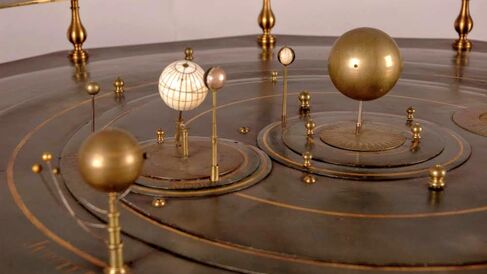The 'Grand' Orrery

An orrery is a moving model of the motions of the Earth, Moon, and Sun. Orreries can be used to demonstrate phenomena such as day and night, the seasons, lunar phases, and eclipses. A candle may be placed in the centre to represent the light of the Sun. Larger orreries often include additional planets and their accompanying satellites.
The Earl of Orrery
The planetary model known as the 'orrery' takes its name from Charles Boyle, the fourth Earl of Orrery. The London instrument maker John Rowley (circa 1668-1728) made the first orrery for Charles Boyle around 1713, but planetary models have existed since ancient times.
London clock- and instrument-maker George Graham (circa 1674-1751), worked with Thomas Tompion (active 1671-1703), to create a number of particularly finely made heliocentric (sun-centred) models. These can be viewed as the predecessors of the orrery. One of these is in the Museum of the History of Science in Oxford (Inventory no. 97810).
During the 18th century in England, astronomy was considered a particularly appropriate pursuit for 'polite society'. It was thought to encourage rational thinking, as well as inspiring contemplation of the splendour of the divinely-created universe. The painting by Joseph Wright of Derby A Philosopher giving that lecture on the Orrery, in which a lamp is put in place of the Sun was first exhibited in London in 1766, and was reproduced in numerous prints (Image 1). In the image, the orrery is used as an aid for the study of astronomy; learning astronomy is portrayed as a social activity, in which children, as well as adults, can participate.
A grand orrery, made by George Adams
This grand orrery (Image 2), which is not to scale, displays the Sun in the centre, and the 6 planets known at the time with their satellites (four around Jupiter and five around Saturn). Saturn is the outermost planet, shown with its ring and the five satellites discovered by Christiaan Huygensand Giovanni Domenico Cassini between 1655 and 1684. The planets Uranus, Neptune and Pluto had not yet been discovered when this orrery was made.
Because this grand orrery is calibrated for the Julian calendar, which was abandoned in favour of the Gregorian calendar system in 1752, the assumption is that it was manufactured before that date. A mahogany table and protective glass dome (not pictured) are later additions.
Signed "Made by GEO ADAMS at TYCHO BRAHE'S HEAD, in Fleet Street LONDON", this grand orrery is by the renowned instrument maker George Adams, who supplied instruments to King George III. This planetarium was very likely purchased by a wealthy customer, and could have been used to demonstrate a number of astronomical phenomena. The large size would have enabled several people, including family and friends, to view it together.
Liba Taub, 'The 'grand' orrery', Explore Whipple Collections, Whipple Museum of the History of Science, University of Cambridge, 2006
